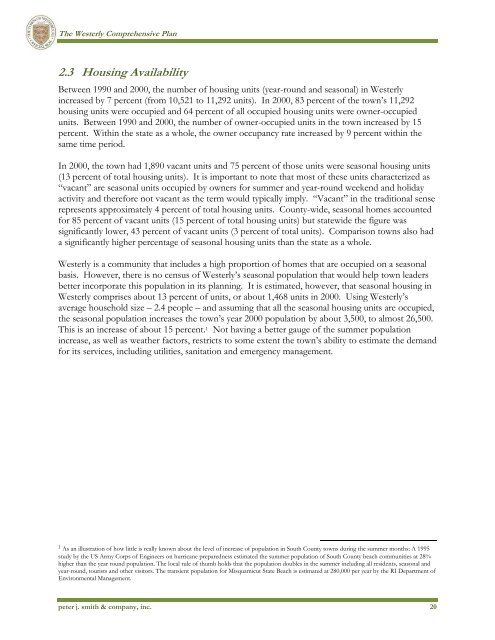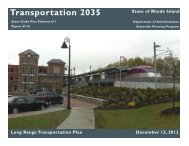Westerly - State of Rhode Island: Division of Planning
Westerly - State of Rhode Island: Division of Planning
Westerly - State of Rhode Island: Division of Planning
Create successful ePaper yourself
Turn your PDF publications into a flip-book with our unique Google optimized e-Paper software.
The <strong>Westerly</strong> Comprehensive Plan2.3 Housing AvailabilityBetween 1990 and 2000, the number <strong>of</strong> housing units (year-round and seasonal) in <strong>Westerly</strong>increased by 7 percent (from 10,521 to 11,292 units). In 2000, 83 percent <strong>of</strong> the town’s 11,292housing units were occupied and 64 percent <strong>of</strong> all occupied housing units were owner-occupiedunits. Between 1990 and 2000, the number <strong>of</strong> owner-occupied units in the town increased by 15percent. Within the state as a whole, the owner occupancy rate increased by 9 percent within thesame time period.In 2000, the town had 1,890 vacant units and 75 percent <strong>of</strong> those units were seasonal housing units(13 percent <strong>of</strong> total housing units). It is important to note that most <strong>of</strong> these units characterized as“vacant” are seasonal units occupied by owners for summer and year-round weekend and holidayactivity and therefore not vacant as the term would typically imply. “Vacant” in the traditional senserepresents approximately 4 percent <strong>of</strong> total housing units. County-wide, seasonal homes accountedfor 85 percent <strong>of</strong> vacant units (15 percent <strong>of</strong> total housing units) but statewide the figure wassignificantly lower, 43 percent <strong>of</strong> vacant units (3 percent <strong>of</strong> total units). Comparison towns also hada significantly higher percentage <strong>of</strong> seasonal housing units than the state as a whole.<strong>Westerly</strong> is a community that includes a high proportion <strong>of</strong> homes that are occupied on a seasonalbasis. However, there is no census <strong>of</strong> <strong>Westerly</strong>’s seasonal population that would help town leadersbetter incorporate this population in its planning. It is estimated, however, that seasonal housing in<strong>Westerly</strong> comprises about 13 percent <strong>of</strong> units, or about 1,468 units in 2000. Using <strong>Westerly</strong>’saverage household size – 2.4 people – and assuming that all the seasonal housing units are occupied,the seasonal population increases the town’s year 2000 population by about 3,500, to almost 26,500.This is an increase <strong>of</strong> about 15 percent. 1 Not having a better gauge <strong>of</strong> the summer populationincrease, as well as weather factors, restricts to some extent the town’s ability to estimate the demandfor its services, including utilities, sanitation and emergency management.1 As an illustration <strong>of</strong> how little is really known about the level <strong>of</strong> increase <strong>of</strong> population in South County towns during the summer months: A 1995study by the US Army Corps <strong>of</strong> Engineers on hurricane preparedness estimated the summer population <strong>of</strong> South County beach communities at 28%higher than the year round population. The local rule <strong>of</strong> thumb holds that the population doubles in the summer including all residents, seasonal andyear-round, tourists and other visitors. The transient population for Misquamicut <strong>State</strong> Beach is estimated at 280,000 per year by the RI Department <strong>of</strong>Environmental Management.peter j. smith & company, inc. 20
















